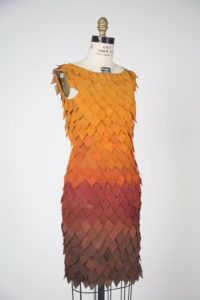
When Birce Ozkan, a Turkish international relations graduate from Istanbul’s Koç University, decided to pursue a Master of Fine Arts degree at Parsons The New School for Design, New York, N.Y., she brought along a number of unique questions about clothing design. “My thesis project was evolved around the questions,” writes Ozkan on her website. “What if when the temperature got hot suddenly, our clothes would start to break apart in response? What if they had the skill to behave depending on the surrounding conditions? What if garments had the ability to sense the environment just like living organisms?”
Her answer is a simple sheath made of fall-toned stylized fabric leaves that actually drift loose from the garment when affected by temperature. Ozkan began her project by researching a tree’s natural mechanism for shedding leaves, “scissor cells” that split, create an additional layer and destabilize leaves so they fall. On the back of a cotton dress base, she installed four arduino micro and servo motors attached to steel wires. Each wire is encased in plastic tubing with tiny holes at regular intervals. Fabric “leaves” made of muslin spray-painted in four fall tones are laser-cut and attached at the tubing holes with wax. Under decreased light conditions, the servos speed up, deform the steel wire, break the wax connection and let the leaves drop.
“I want clothing to have more responsiveness to the environment,” says Ozkan, “so that instead of people always [changing] their clothes, the clothes can sometimes change themselves.”
 TEXTILES.ORG
TEXTILES.ORG


